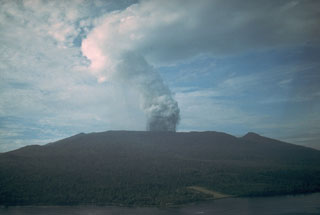Report on Karkar (Papua New Guinea) — June 1980
Scientific Event Alert Network Bulletin, vol. 5, no. 6 (June 1980)
Managing Editor: David Squires.
Karkar (Papua New Guinea) Fumarolic activity continues
Please cite this report as:
Global Volcanism Program, 1980. Report on Karkar (Papua New Guinea) (Squires, D., ed.). Scientific Event Alert Network Bulletin, 5:6. Smithsonian Institution. https://doi.org/10.5479/si.GVP.SEAN198006-251030
Karkar
Papua New Guinea
4.647°S, 145.976°E; summit elev. 1839 m
All times are local (unless otherwise noted)
"An aerial inspection on 28 June indicated that conditions in the 1979 crater were similar to those during the previous inspection on 10 May. Fumarolic activity on Bagiai Cone may have strengthened since the May inspection, while fumarolic activity on the caldera floor appeared to have weakened over the same time interval. Seismic activity remained unchanged."
Geological Summary. Karkar is a 19 x 25 km forest-covered island that is truncated by two nested summit calderas. The 5.5 km outer caldera was formed during one or more eruptions, the last of which occurred 9,000 years ago. The steep-walled 300-m-deep, 3.2 km diameter, inner caldera was formed sometime between 1,500 and 800 years ago. Cones are present on the N and S flanks of this basaltic-to-andesitic volcano; a linear array of small cones extends from the northern rim of the outer caldera nearly to the coast. Recorded eruptions date back to 1643 from Bagiai, a pyroclastic cone constructed within the inner caldera, the floor of which is covered by young, mostly unvegetated andesitic lava flows.
Information Contacts: C. McKee, RVO.

